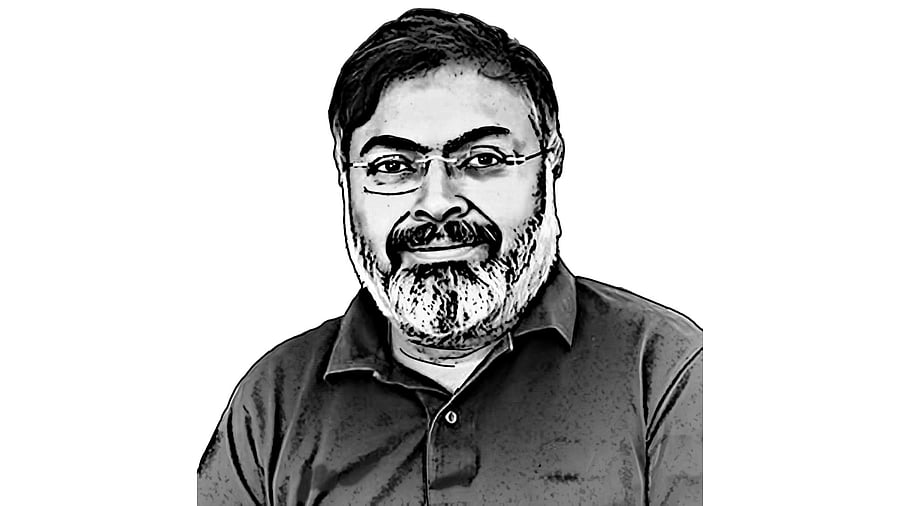
Devdutt Pattanaik works with gods and demons who churn nectar from the ocean of Indian, Chinese, Islamic, Christian, even secular mythologies.
In recent years, there has been a growing clash between ‘Sanatani mythology’ and ‘Dalit mythology’. During the festival season last month, a well-known Dalit activist argued that the worship of Durga is nothing but the celebration of an Aryan invasion of Dravidian lands. In his retelling, Mahishasur, the buffalo demon, represents dark-skinned Dravidians while Durga represents fair-skinned Aryans.
Because this retelling comes from a Dalit scholar, any challenge to it is immediately painted as casteist. But the Dalit retellers are following the toolkit long used by Sanatani activists who brand their critics as anti-national or communist. This is how ideological battles are fought today. Labels need to be weaponised. Myths need to be reimagined.
Political groups across the spectrum have always bent old stories to fit new narratives. In his 1873 book Gulamgiri (Slavery), Jyotiba Phule reimagined the Devas-Asuras wars as colonisation of ancient Dravidian lands by Aryan infiltrators. Great Asura kings like Prahalad, Virochana, and Bali were seen as demons. By turning ‘gods’ into colonisers and ‘demons’ into heroes, Phule gave Bahujan communities a counter-history. If Brahmins could use mythology to establish their supremacy, surely Dalits could use the same for social justice.
Sanatanis have long tried to debunk the Aryan Invasion Theory (AIT), arguing it was simply colonial propaganda. Some even propose the Out of India Theory (OIT) that claims Brahmins gave civilisation to the world. Ironically, it was Balgangadhar Tilak, the founding father of the Sanatani political ideology, who first decoded astronomy-based Vedic hymns to show that the Aryan homeland may have been north of the Himalayas, near the Arctic, probably. The Vedic ‘Usha’ hymns spoke of a land where there were dawns without any visible sun.
In the 20th century, Babasaheb Ambedkar rejected AIT as it was a racial theory aimed at establishing Brahmin-European-Aryan superiority. He argued caste was a social, economic, and political problem, not a racial one. But now, in the 21st century, we have a new source of evidence – genetics! DNA studies clearly show migration of Steppe pastoralists and horses into India took place over 3,000 years ago. Aryans did come to India. But not as invaders who destroyed the Harappan cities. They came to trade Central Asian horses for Indian iron, 500 years after Harappan cities had ceased to exist.
Both Sanatani and Dalit activists rarely bother with art or ritual history. The image of Durga with many arms, killing the buffalo, first appeared around 2,000 years ago in Kushan art (100 AD). It was first carved in stone during the Gupta period (400 AD). The Sanskrit story of Durga being created by the gods and restoring paradise to Indra appears much later in the Markandeya Purana (600 AD).
Across India, especially in the Deccan, there are folk traditions where worship of the goddess involves a ritual slaughter of a buffalo. These orally transmitted tales are fragmentary and layered. The young, virile priest who performs the ritual is called Pota Raju, the Buffalo King. He, typically, hails from a ‘low’ caste. He calls himself the servant and son of the goddess. He leads the procession to the temple. The goddess is pleased by rituals involving violence (fire-walking, hook-swinging, blood sacrifice). Every year, a young male buffalo (reda, in the local language) is chosen to be slaughtered the following year, a ritual mimicry of the renewal of earth’s fertility. This suggests that the festival originally had little to do with grand cosmic battles between gods and demons. It was an agricultural ritual, deeply tied to cycles of sowing and harvesting. This story has nothing to do with the Vedic world.
Brahmins, who rarely participate in such boisterous village rituals, insist the goddess of the village was once a Brahmin girl. She was tricked into marrying a beef-eating man. When she discovered this, she killed him, and that event is remembered each year. They argue this is why many goddess temples are now vegetarian – the Chamunda temple in Mysuru, the Ambabai temple in Kolhapur. In fact, many Sanatanis think Bengalis need to stop offering meat and fish to Durga during their annual Pujo. Dalit myth-makers are using this very same story to make the outraged Brahmin’s daughter the symbol of Aryan oppression and her beef-eating husband the embodiment of the oppressed.
Today, young Dalit activists are raising foundational questions: who makes the rules of Hinduism? Do those categorised as ST/SC have any say in the matter? Who classified those who eat cow meat as impure and those who drink cow urine as pure? It could not have been the goddess or the buffalo.
The writer works with gods and demons who churn nectar from the ocean of Indian, Chinese, Islamic, Christian, even secular mythologies.
Disclaimer: The views expressed above are the author's own. They do not necessarily reflect the views of DH.